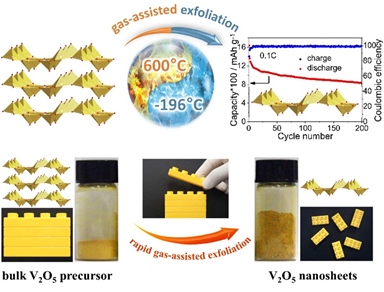Recently, a novel work named as “Rapid gas-assisted exfoliation promises V2O5nanosheets for high performance lithium-sulfur batteries” (10.1016/j.nanoen.2019.104253) was published in Nano Energy (IF: 16.602) by Chao Wang in our institute. And our institute contribute the most in this work.

The lithium-sulfur battery (Li-S battery) is a type of rechargeable battery, notable for its high specific energy. Unfortunately, their implementation has been hindered by several issues: (1) the insulating properties of S and lithium sulfide, (2) the notorious shuttling of the polysulfides, and (3) huge volume fluctuations (≈80%). These issues can result in low S utilization, poor Coulombicefficiency and rapid capacity decline, respectively. And these problems arise mainly from the dissolution of reaction intermediates (Li2Sn, 4 <n< 8) in the electrolyte. A series of commonly used methods have been developed to deal with the issues mentionedabove, for instance, (1) incorporating S into host materials with high specific surface area and abundant polar sites and (2) applying functional interlayers and binders. Herein, an efficient, nontoxic thermal expansion-triggered gas-assisted exfoliation method for rapid preparation of 2D ultra-thin V2O5nanosheets is introduced with using commercially available bulk V2O5as precursor. With this facile exfoliation method, extremely clean V2O5nanosheets (<3 nm) could be obtained, as no impurities would be introduced during exfoliation process. Specifically, the introduction of the exfoliated V2O5nanosheets can help to constrain polysulfides in the electrolyte effectively, and Li–S batteries based on V2O5-S composite electrode can deliver a high initial discharge specific capacity (1638.5 mAh g-1) and along cycle life (838.8 mAh g-1after 200 cycles). This work not only provides a novel electrode material as a host for S cathodes in high-energy-density and long-cycle-life Li-S batteries, but also shares new insight for the production of few-layered TMOs (like MnO2, MoO3, WO3or TiOx), which can be used in the fields of Li-S batteries, selective catalytic reduction reactions, water splitting, CO2activation and many other areas.
This research was funded by the National Natural Science Foundation of China (Nos. 21722604, 21808092 and 21978231). The work was completed by Jiangsu University, Xi’an Jiaotong University and Oak Ridge National Laboratory (USA). Prof. Dr. Wenshuai Zhu, Prof. Dr. Mingtao Li and Prof. Dr. Sheng Dai are the corresponding author of this work.


